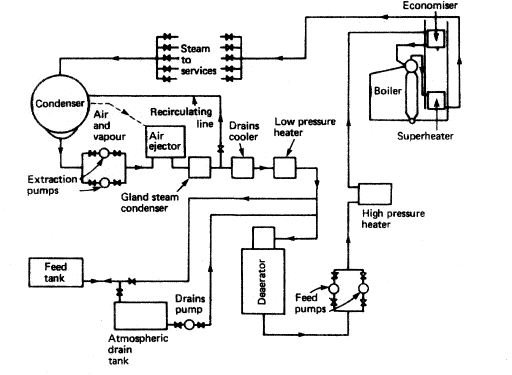Closed Feed Water Boiler System Explained
Introduction
The main difference between an open feed system and a closed feed system is that in a closed feed system none of the parts of the system are exposed to the environment, as you will later see in the feed water system diagram.Closed feed system is generally used in a high pressurized system such as a high pressure water tube boiler supplying steam to the main propulsion steam turbine.
The main parts of a closed feed system are:
- A regenerative type condenser
- Air ejector
- Extraction pump
- De-aerator
- Feed tank.
The Closed Feed System
The high pressurized steam from the boiler enters the steam turbine and exits in the form of low energy steam, which then enters the condenser. A closed feed system mostly consists of a regenerative type of condenser, which allows condensation of the steam with less drop in the temperature level. Once the condensate collects in the condenser, it is extracted with the help of extraction pumps and is then circulated to the air ejector.
The air ejector does the work of removing dissolved oxygen from the water. This helps to prevent corrosion of internal parts of the boiler. The condensate is heated as it passes through the condenser. The air is removed from the condensate using steam operated ejectors.
After removal of the oxygen, the condensate is passed through a gland steam condenser, which further heats the condensate. The gland steam condenser is a heat exchanger in which the turbine gland steam is condensed and drained to the atmospheric drain tank. The condensate after getting heated is then passed through a low pressure heater, which uses bled steam from the turbine. The main aim of using all these condensers and heat exchangers is to prevent wastage of heat from the system and thus increase the feed water temperature to assist in the de-aeration process.
De-aerator
The de-aerator used in a closed feed system is a direct contact feed heater. This means that in the heat transfer process, the steam and feed water literally comes in direct contact with each other and actually mixes. As the temperature of the water rises, any dissolved oxygen present in the feed water is released.
There is a feed water storage tank at the bottom of the de aerator, which is used to supply feed water to the main feed pumps. One of the two feed pumps supplies the required feed water to the boiler. The feed water before reaching the boiler, passes through a high pressure feed heater. The high pressure feed heater further increases the temperature of the feed water. The feed water then passes through an economizer, before finally entering the boiler drum.
The atmospheric drain tank of the system collects drains from various installations such as gland steam, air ejector steam etc. The main need of the atmospheric drain tank is to supply additional feed water to the system whenever needed. In order to prevent any kind of mishap during low load and manoeuvring operations, a recirculating feed line is provided to ensure adequate flow of feed water through the air ejector and gland steam condenser.
According to the type of the ship and the volume of steam required, various modification are made in the closed feed system.
Images
Introduction of Marine Engineering 2nd Edition by D.A Taylor
